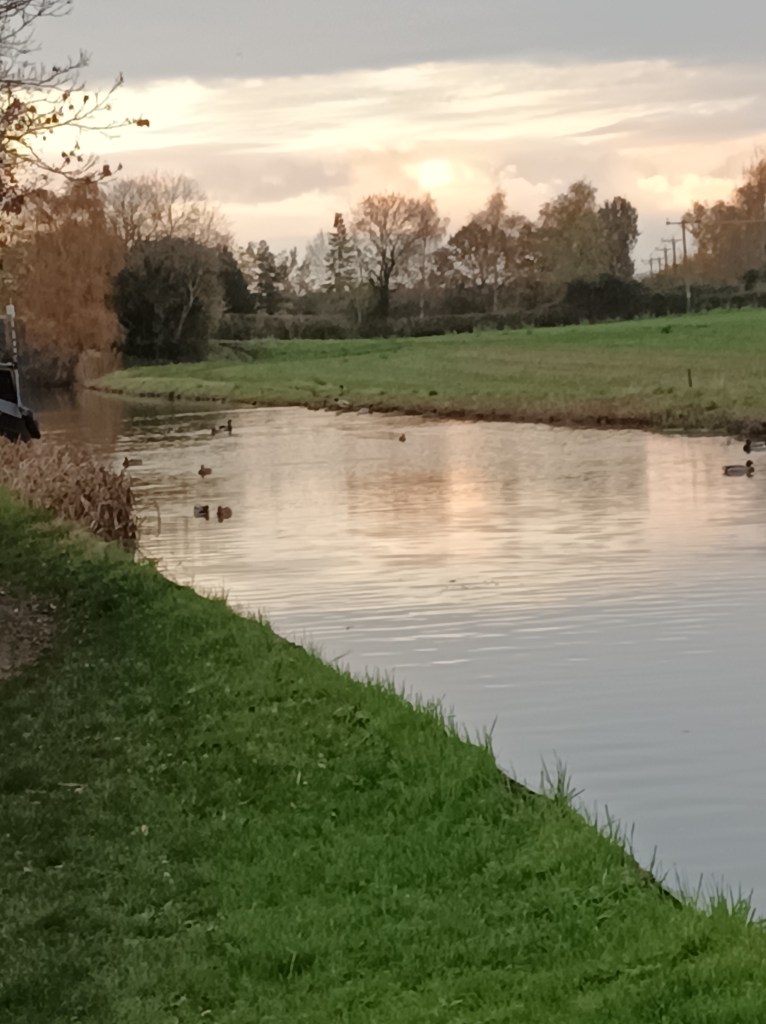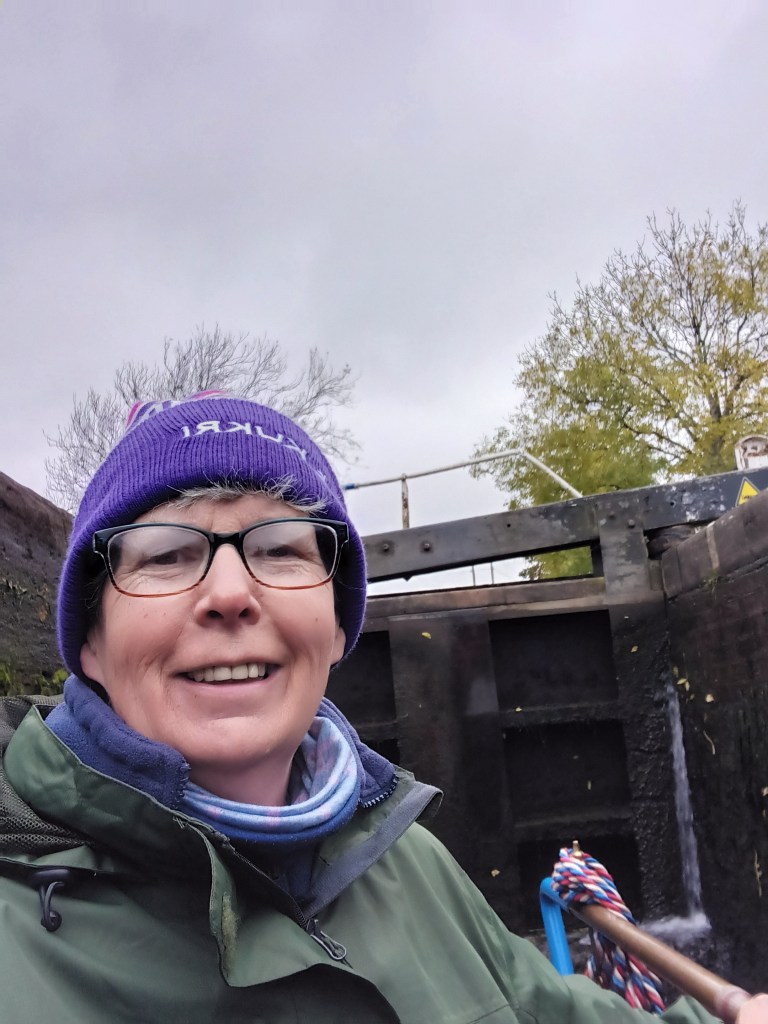Living afloat brings so many dimensions to life. Some are expected – like being able to move on when you don’t fancy the location (or the neighbours), or you feel you’ve explored everything you can in that place, but some are totally unexpected.
The sensory scope of each place is remarkable, and unless you are consciously listening or seeing you could miss out on a hugely rich part of life. It is most apparent at this time of the year when dusk falls early and the night is long.
On Sunday (after successfully completing the Seagrave Wolds Challenge of 17.2miles and thoroughly enjoying it as usual) we were still moored on the Ashby Canal, in a rural location amid fields of cows and ponies. No streetlights created a velvety blackness at night; a deadening carpet of yellow and brown fallen leaves muffling dog walkers’ footsteps as they passed the boat at dusk; night brought us the occasional car horn anxiously approaching the nearest canal bridge, but apart from that, the sounds were totally the sounds of nature – shrill moorhen squawks, the gentle hooting of a tawny owl, scuffling of small creatures moving through the towpath leaves.

In the early morning the bullocks in the adjoining field bellowed, and a distant donkey joined in the chorus with an asthmatic hee-hee-heee which just occassionally ended in a haw. The sparrows and robins, blackbirds and blue tits created a constant background symphony in the hedge alongside us, apparently unaffected by our presence.
Monday took us onto the Coventry Canal, moored on the outskirts of Nuneaton.

It was a very different place to stay. There were houses on the far side of the canal. Close to each other but detached, modern homes with gardens coming down to the water, each with its own character telling you something of their inhabitants. Some clearly housed children of differing ages, with brightly coloured plastic play houses, sandpits with lids and trampolines; others are homes of obvious plant enthusiasts with specimen trees and carefully tended herbaceous beds; others point to hedonist inhabitants with hot tubs, swinging chairs and hammocks. Garden buildings doubled as offices, or “Dad’s bar” and lots of plastic rattan furniture in shades of gray and black, some with covers, some without. At night solar fairy lights appeared along many fences. For all the apparent human presence it was silent on that side of the canal.
On our side of the water, walkers passed soundlessly on newish, well made paths. Ducks chattered alongside a solitary swan. The birds kept up a steady flow of conversation and made their presence heard (and felt too as they tapped their beaks against our steel hull to see if there’s interesting edible weed attached to us that they can enjoy). The occasional train rumbled past but there are few regular services on this branch line. Sudden shrill sirens on distant roads reminded us of how close we are to the hustle and bustle of a town.
After eleven delightfully easy and well maintained narrow locks down the canal, through the market town of Atherstone in Warwickshire, we came to our third mooring of the week.
There are boats on both sides of the canal here – long term moorings opposite us, with a huge variety of boats, narrowboats, cruisers, converted tugs. Some permanent homes, some used on high days and holidays, others in the throes of being made habitable. A service point beside them – provides a necessary opportunity to remove the waste from the boat and fill up with water.

A railway rumbled intermittently and regularly in the distance; a little-used lane over a canal bridge ahead brought the sound of vehicles, and beyond the long term moorings a large property was guarded by occasionally vocal dogs that sounded fittingly large too. It was at times though remarkably quiet here, and that included birdsong. I saw no birds on the water and the hedge alongside our mooring seemed bereft of inhabitants. Walking the dog just 50 yards beyond the bustle by the moorings and the wildbirds appeared. They’ve chosen a quieter, more peaceful location.
Human accents have changed too – at 5.30am in the morning we clearly heard two men heading from boats to work, or perhaps going out to fish. The monotonal Brummie twang was very apparent.
Then we moved on two locks to our third and final mooring of the week, and possibly a home for the next two weeks – Hopwas in Staffordshire, a short hop from Tamworth, a market town famed for its Titian-tinted pigs.
We moored on the outskirts of the village. Last time we were here we strayed too early into the beautiful woods for our morning walk. Inadvertently we then found ourselves trapped as it became a live military firing range! This time we’ve downloaded the firing times from the MOD website and have yet to hear evidence of anyone firing, in anger or anything else!
Sounds here are muffled and amplified by layer upon layer of fallen leaves – footsteps crackling through the dry top tier, activities of wildlife amplified by the scuffling sounds their paws and beaks make in the fallen foliage.

The woods, despite their military use, are full of birds and creatures scurrying to and fro, the world being their own until borrowed by walkers and soldiers for a time. There are ducks on the water and the occasional moorhen too.
This life afloat surrounded by nature is teaching me to hear – to listen better. It’s a lesson I wish I had appreciated sooner, particularly in business and in education. I hear the crackle of dry leaves on the woodland paths but miss the scamper of a squirrel or the frenzied digging of of Jay seeking acorns. Sometimes snap decisions are based on the initial or apparent information easily offered, but that doesn’t always lead to the ideal solution, because other information which could lead to a full response goes unheard, unrecognised. It’s something I know from experience that sometimes speedy solutions or responses receive more recognition than those that take longer to craft. Speed is sadly in our fast-paced world, often synonymous with efficiency and professionalism when actually it may lead to a shallow response that doesn’t really resolve all of the issue.
Taking time to make a decision and a judgment is not a waste of time but an investment. Taking time to really hear what’s really going on around me informs a competence that prevents negligence or wastefulness.
It’s tough really listening, really hearing but it repays the effort I put in to it, in so many ways. It uses my senses better- by listening fully I can see so much more, saving time and money, effort and error. I am sure I , and those around me, can benefit from me being more aware and more alert.
Taking time to hear what’s going on around me, to appreciate the complexity, the multi layered environment that envelops me isn’t easy, but it richly repays the effort of listening and seeking to understand my changing world. I am not only aware of more around me, but aware I get so much more out of the world by doing so.






